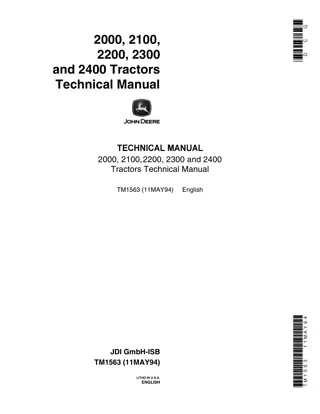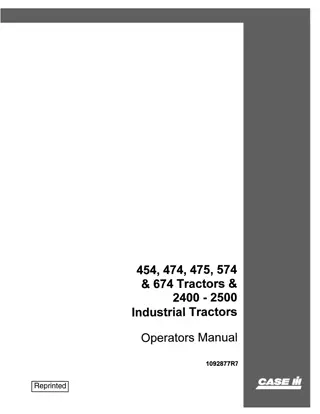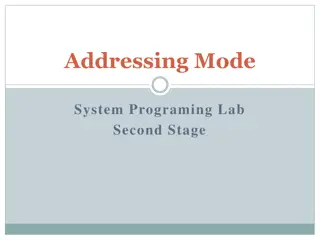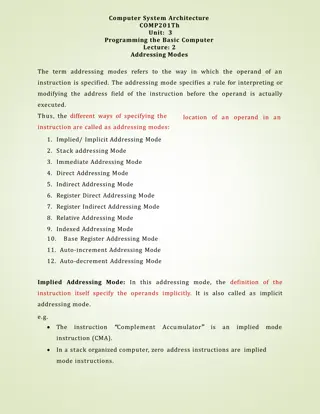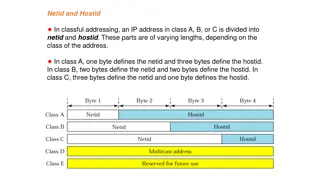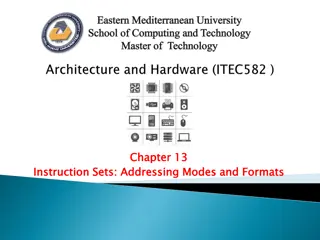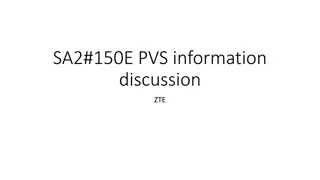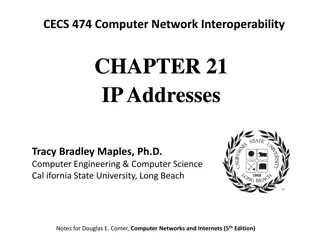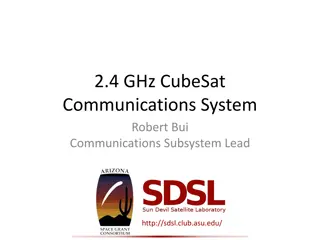
Learn ARM Assembly Data Transfer Operations
Dive into ARM assembly operations for data transfer between the CPU and memory. Explore memory concepts, data transfer instructions, register-indirect addressing, and the role of registers in ARM architecture.
Download Presentation

Please find below an Image/Link to download the presentation.
The content on the website is provided AS IS for your information and personal use only. It may not be sold, licensed, or shared on other websites without obtaining consent from the author. If you encounter any issues during the download, it is possible that the publisher has removed the file from their server.
You are allowed to download the files provided on this website for personal or commercial use, subject to the condition that they are used lawfully. All files are the property of their respective owners.
The content on the website is provided AS IS for your information and personal use only. It may not be sold, licensed, or shared on other websites without obtaining consent from the author.
E N D
Presentation Transcript
Chapter 4 Addressing modes CEG2400 Microcomputer Systems CEG2400 ch4 addressing modes v7a 1
Objective In this lecture, you will learn some assembly operations for data transfer from CPU to memory / from memory to CPU CEG2400 ch4 addressing modes v7a 2
Overview 1. Memory concept revision 2. Data Transfer Instructions - LDR instruction (Load Address into Register) Ref: http://infocenter.arm.com/help/index.jsp?topic=/co m.arm.doc.dui0041c/Babbfdih.html 3. Register-indirect addressing using load (LDR) / store (STR) 4. Block copying CEG2400 ch4 addressing modes v7a 3
1)Memory concept labels 32-bit Address (HEX) 0000 0000 8-bit data Program/Data Org 03 0000 0001 24 Program Program code and data are saved in memory. They occupy different locations : Four 8-bit data form a 32-bit word TABLE1 0001 0000 12 0001 0001 3B See appendix For big/little endian formats 0001 0002 A4 0001 0003 34 0001 0004 B2 0001 0005 D2 : TABLE2 0002 0000 24 0002 0001 6C : CEG2400 ch4 addressing modes v7a 4
2) Data Transfer Instructions - LDR instruction (Load Address into Register) LDR r1, =adress_label It is a pseudo instruction (Combining several instructions) Details, see appendix for how it is actually implemented E.g. LDR r1, =TABLE1 If TABLE1 is at 0001 0000H, then r1 = 0001 0000H after the instruction is run. Similarity for r2 and TABLE 2. copy1 LDR r1, =TABLE1 ; r1 points to TABLE1 copy2 LDR r2, =TABLE2 ; r2 points to TABLE2 . TABLE1 TABLE2 ; <source of data> ; <destination of data> Ref: http://infocenter.arm.com/help/index.jsp?topic=/com.arm.doc.dui0041c/Babbfdih.html CEG2400 ch4 addressing modes v7a 5
3) Register-indirect addressing using load (LDR) / store (STR) http://infocenter.arm.com/help/index.jsp?topic=/com.arm.doc.dui0041c/Babbfdih.html CEG2400 ch4 addressing modes v7a 6
How we can operate the data inside memory? In ARM architecture, data must place in register before performing basic operations You can t perform operation directly to memory Data Register Data Register Data Data Memory Memory CEG2400 ch4 addressing modes v7a 7
Reason to use Load (LDR) / store (STR) Therefore, we need the operation to help us load the data from memory to register, and store the data from register to memory. CEG2400 ch4 addressing modes v7a 8
Data Transfer Instructions - single register load/store instructions Use a value in one register (called the base register) as a memory address [ ] and either loads the data value from that address into a destination register or stores the register value to memory (mem32[r1] means: r1 holds the address, mem32[r1] =data content): LDR r0, [r1] ; r0 := mem32[r1] ;(content in r1 is an address) r0, [r1] ; mem32[r1] := r0 This is called register-indirect Because we are not accessing the data directly addressing LDR r0, [r1] STR Address memory r0 DDDD DDDD DDDD DDDD AAAA AAAA r1 AAAA AAAA CEG2400 ch4 addressing modes v7a 9
Example : Data Transfer Instructions Use LDR copy LDR LDR LDR STR r1, =TABLE1 r2, =TABLE2 r0, [r1] r0, [r2] ; r1 points to TABLE1 ; r2 points to TABLE2 ; load first value . ; and store it in TABLE2 . TABLE1 TABLE2 ; <source of data> ; <destination of data> CEG2400 ch4 addressing modes v7a 10
Exercise 4.1 Fill in the shaded areas. Address (H) Comments After instruction is run (hex) start All registers are rest to 0 here 0004 0000 (TABLE2) R0 R1 R2 0001 0000 copy LDR r1,=TABLE1 ;r1 points to TABLE1 LDR r2,=TABLE2 ;r2 points to TABLE2 LDR r0, [r1] ;load first value STR r0, [r2] ;and store it in TABLE2 : : 0002 0000 TABLE1 12345678 ;<source of data> : 0004 0000 TABLE2 00000063 ;<destination of data> CEG2400 ch4 addressing modes v7a 11
Block copy for two data: Data Transfer Instructions The following example copies data from TABLE1 to TABLE2 (show how to copy two values) copy LDR LDR LDR STR ADD ADD LDR STR r1, =TABLE1 r2, =TABLE2 r0, [r1] r0, [r2] r1, r1, #4 r2, r2, #4 r0, [r1] r0, [r2] ; r1 points to TABLE1 ; r2 points to TABLE2 ; load first value . ; and store it in TABLE2 ; add 4 to r1 ; add 4 to r2 ; load second value . ; and store it in TABLE2 .. TABLE1 TABLE2 ; <source of data> ; <destination of data> CEG2400 ch4 addressing modes v7a 12
Exercise 2 --page1 Block copy for N=5 data : Data Transfer Instructions Copy N=5 data from TABLE 1 to TABLE2 1. copy 2. 3. 4.loop1 5. 6. 7. 8. 9. 10. TABLE1 TABLE2 LDR LDR MOV LDR STR ADD ADD ADD CMP BNE .. r1, =TABLE1 r2, =TABLE2 r3,#0 r0, [r1] r0, [r2] r1, r1, #4 r2, r2, #4 r3, r3, #1 r3,#5 loop1 ; TABLE1=0002 0000H ; TABLE2=0004 0000H ;setup counter at R3 ; load first value . ; and store it in TABLE2 ; add 4 to r1 ; add 4 to r2 ; increment counter ; repeat N=5 ; loop back when N<5 ; <source of data> ; <destination of data> CEG2400 ch4 addressing modes v7a 13
Exercise 2 --page2, Fill in blacks (hex) for the loop after each time line 9 is executed After line 9 is run Time=1 Time=2 Time=3 Time=4 Time=5 R3 (Hex)= 1 2 3 4 5 R0 (Hex) 0000 00A1 R1 (Hex) 0002 0004 R2 (Hex) 0004 0004 Z (zero) of CPSR,Z=1 if result 0 else Z=0 0 Table 1, from 0002 0000- 0002 0013H 0000 00A1 0000 00B2 0000 00C3 0000 00D4 0000 0055 Table 2, from 0004 0000- 0004 0013H 0000 00A1 0000 0000 0000 0000 0000 0000 0000 0000 14 CEG2400 ch4 addressing modes v7a
4) Block copying: We will study these for block data copy LDR LDR LDR LDR r0, [r1] r0, [r1 , # offset] r0, [r1 , # offset]! r0, [r1], # offset ; register-indirect addressing ; pre-indexed addressing ; pre-indexed, auto-indexing ; post-indexed, auto-indexing CEG2400 ch4 addressing modes v7a 15
Use of pre-indexed addressing mode LDR r0, [r1, #offset] Base plus offset addressing pre-indexed addressing mode LDR r0, [r1, #4] ; r0 := mem32 [r1 + 4] effective address base address offset r1 Unchanged LDR r0, [r1, #4] ; r0 : = mem32 [r1 + 4] r1 will not be changed by pre-indexed addressing instructions CEG2400 ch4 addressing modes v7a 16
Pre-indexed addressing, LDR r0, [r1, #offset] Copy and copy2 (shown below) have the same effect copy LDR LDR LDR STR ADD ADD LDR STR r1, =TABLE1 r2, =TABLE2 r0, [r1] r0, [r2] r1, r1, #4 r2, r2, #4 r0, [r1] r0, [r2] ; r1 points to TABLE1 ; r2 points to TABLE2 ; load first value . ; and store it in TABLE2 ; step r1 onto next word ; step r2 onto next word ; load second value ; and store it Simple method copy2 LDR LDR LDR STR LDR STR r1, =TABLE1 r2, =TABLE2 r0, [r1] r0, [r2] r0, [r1, #4] r0, [r2, #4] ; r1 points to TABLE1 ; r2 points to TABLE2 ; load first value . ; and store it in TABLE2 ; load second value ; and store it Better method using pre-indexing CEG2400 ch4 addressing modes v7a 17
Pre-indexed with auto addressing mode LDR r0, [r1, #offset]! pre-indexed auto addressing mode, using (!), changes the pointer reg. (e.g. r1 here ) after used. LDR r0, [r1, #4]! ; r0 := mem32 [r1 + 4] base address offset effective address r1 = r1+offset=r1+#4 LDR r0, [r1, #4]! ; r0 : = mem32 [r1 + 4] ; r1 := r1 + 4 CEG2400 ch4 addressing modes v7a r1 will be changed by pre-indexed addressing instructions 18
Exercise 4.3 LDR r0, [r1, #4] ; r0 : = mem32 [r1 + 4] LDR r0, [r1, #4]! ; r0 : = mem32 [r1 + 4] ; r1 := r1 + 4 1. Copy LDR r1, =TABLE1 2. LDR 3. LDR 4. STR 5. LDR 6. STR (all in hex) ; TABLE1=0002 0000 ; TABLE2=0004 0000 ; load first value . ; and store it inTABLE2 ; load second value ; and store it r2, =TABLE2 r0, [r1] r0, [r2] r0, [r1, #4] r0, [r2, #4] After Line r0 r1 r2 0002 0000- 0002 0003 0002 0004- 0002 0007 0004 0000- 0000 4003 0004 0004- 0004 0007 1 0000 0000 0002 0000 0000 0000 1357 2468 A123 B246 0 0 2 3 4 5 6 CEG2400 ch4 addressing modes v7a 19 r1,r2 will NOT be changed by pre-indexed addressing instructions
Exercise 4.4 LDR r0, [r1, #4]! ; r0 : = mem32 [r1 + 4] ; r1 := r1 + 4 LDR r0, [r1, #4] ; r0 : = mem32 [r1 + 4] 1.Copy LDR 2. 3. 4. 5. 6. r1, =TABLE1 r2, =TABLE2 r0, [r1] r0, [r2] r0, [r1, #4]! r0, [r2, #4]! ; TABLE1=0002 0000 ; TABLE2=0004 0000 ; load first value . ; and store it inTABLE2 ; load second value,r1 will change ; and store it, r2 will change too LDR LDR STR LDR STR (all in hex) After line r0 r1 r2 0002 0000- 0002 0003 0002 0004- 0002 0007 0004 0000- 0004 0003 0004 0004- 0004 0007 1 0000 0000 0002 0000 0000 0000 1357 2468 A123 B246 0 0 2 3 4 5 6 CEG2400 ch4 addressing modes v7a 20 r1,r2 will be changed by pre-indexed addressing instructions
Data Transfer Instructions - post-indexed addressing Another useful form of the instruction is: LDR r0, [r1], #4 ; r0 : = mem32 [r1] ; then r1 := r1 + 4 This is called: post-indexed addressing - the base address is used without an offset as the transfer address, after which it is auto- indexed:(r1=r1+4) Using this, we can improve the copy program: copy LDR r1, =TABLE1 LDR r2, =TABLE2 loop LDR r0, [r1], #4 STR r0, [r2], #4 ??? TABLE1 ; r1 points to TABLE1 ; r2 points to TABLE2 ; get TABLE1 1st word . ; copy it to TABLE2 ; if more, go back to loop ; < source of data > CEG2400 ch4 addressing modes v7a 21
Summary :Data Transfer Instructions (LDR-- >LDRB) Size of data can be reduced to an 8-bit byte with: LDRB r0, [r1] ; r0 : = mem8 [r1] Summary of addressing modes: LDR LDR LDR LDR LDR r0, [r1] r0, [r1 , # offset] r0, [r1 , # offset]! r0, [r1], # offset r0, =address_label ; register-indirect addressing ; pre-indexed addressing ; pre-indexed, auto-indexing ; post-indexed, auto-indexing ; PC relative addressing CEG2400 ch4 addressing modes v7a 22
Self study programming exercise:;ex4_2400 ch4 of CENG2400. It is for your own revision purpose, no need to submit answers to tutors. ; User Initial Stack & Heap AREA |.text|, CODE, READONLY EXPORT __main __main ;clear flags memory_init table1 loop ADD r0,r0,#0x11 ex4_1 ;;;;;;;;;;;;;;;;;;;;;;;;;;;;;;;;;; ;http://www.cse.cuhk.edu.hk/%7Ekhwong/www2/c eng2400/ex4_2400_qst.txt; 1) create a project based on this .s code ;2) In keil-ide, use project/rebuild all target files to build the project ;3) use Debug/run_to_cursor_line to run the top line of the program, ;4) use the single step mode to view the memory locations (in DEbug mode/view/memory_wndows)from 0x4000000 to 0x40000013, registers and cpsr after the execution of each statement. ;5) Explain the observations and results. ; set the memory content in LDR r1, =Table1 LDR r2, =Table2 MOV r3,#0 MOV r0,#0x00 STR r0,[r1] ADD r1,r1,#4 ADD r3,r3,#1 CMP r3,#10 BNE loop NOP NOP ; declare variables New test12D AREA Table1 DCD 0x1, 0x1, 0x1, 0x1, 0x1, 0x1, 0x1, 0x1 ,0x1, 0x1 Table2 DCD 0x1, 0x1, 0x1, 0x1, 0x1, 0x1, 0x1, 0x1 ,0x1, 0x1 align ;------------------------------------------------------------- BL memory_reset LDR r1,=Table1 LDR r2,=Table2 LDR r0, [r1] STR r0, [r2] NOP |.data|, DATA, READWRITE CEG2400 ch4 addressing modes v7a 23
ex4_3;;;;;;;; ex4_4;;;;;;;; memory_reset ; reset the content in ; table2 to be all 0 LDR r5,=Table2 MOV r6,#0 MOV r7,#0 loop2 STR r6,[r5] ADD r5,r5,#4 ADD r7,r7,#1 CMP r7,#10 BNE loop2 BX LR END Self study exercises (continue) BL memory_reset LDR r1,=Table1 LDR r2,=Table2 LDR r0,[r1] STR r0,[r2] LDR r0,[r1,#4] STR r0,[r2,#4] NOP NOP ex4_2;;;;;;;;;;;;;;;;;;;;;;;;;;;;;;;;;; BL memory_reset LDR r1,=Table1 LDR r2,=Table2 MOV r3, #0 loop1 LDR r0,[r1] STR r0,[r2] ADD r1,r1,#4 ADD r2,r2,#4 ADD r3,r3,#1 CMP r3,#5 BNE loop1 NOP NOP BL memory_reset LDR r1,=Table1 LDR r2,=Table2 LDR r0,[r1] STR r0,[r2] LDR r0,[r1,#4]! STR r0,[r2,#4]! NOP NOP CEG2400 ch4 addressing modes v7a 24
Summary Learned the addressing modes of the Arm processor CEG2400 ch4 addressing modes v7a 25
Appendices CEG2400 ch4 addressing modes v7a 26
Appendix 1: MOV MOV : Move MOV<suffix> <dest>, <op 1> dest = op_1 MOV loads a value into the destination register, from another register, a shifted register, or an immediate value. You can specify the same register for the effect of a NOP instruction, or you can shift the same register if you choose: MOV R0, R0 ; R0 = R0... NOP instruction MOV R0, R0, LSL#3 ; R0 = R0 * 8 If R15 is the destination, the program counter or flags can be modified. This is used to return to calling code, by moving the contents of the link register into R15: MOV PC, R14 ; Exit to caller MOVS PC, R14 ; Exit to caller preserving flags (not 32-bit compliant) CEG2400 ch4 addressing modes v7a 27
Appendix2: Data Transfer Instructions - ADR instruction How does the ADR instruction work? Address is 32-bit, difficult to put a 32- bit address value + opcode in a register in the first place Solution: Program Counter PC (r15) is often close to the desired data address value ADR r1, TABLE1 is translated into an instruction that adds or subtracts a constant to PC (r15), and puts the results in r1 This constant is known as PC-relative offset, and it is calculated as: addr_of_table1 - (PC_value + 8) By programmer Address opcode 00008FE4 E28F0004 ADR R0, table1 ; pseudo instruction ; now pc=r15= 00008FE4 Real instruction 00008FE4 E28F0004 ADD R0, R15, #4 ;real code 00008FF0 .table1 00008FF0 EQUS Hello world !" CEG2400 ch4 addressing modes v7a 28
The use of the pseudo instruction ADR You write Address opcode 00008FE4 E28F0004 ADR R0, table1 ; pseudo instruction ; now pc=r15= 00008FE4 Real instruction (generated by the assembler) 00008FE4 E28F0004 ADD R0, R15, #4 ;real code 00008FF0 .table 00008FF0 EQUS Hello world !" ---Explanation--- The location you want to enter into R0 is .text = 00008FF0 , which is the beginning of a string table. But you cannot place a 32-adress and some opcode into 32-bit Because ARM designers want to maintain each instruction is 32-bit long Put location (PC+8)= 00008FF0-(00008FE4+8)=# 4 instead Note: # n =the actual number n (not an address) CEG2400 ch4 addressing modes v7a 29
End CEG2400 ch4 addressing modes v7a 30
Appendix Big and little endian CEG2400 ch4 addressing modes v7a 31




